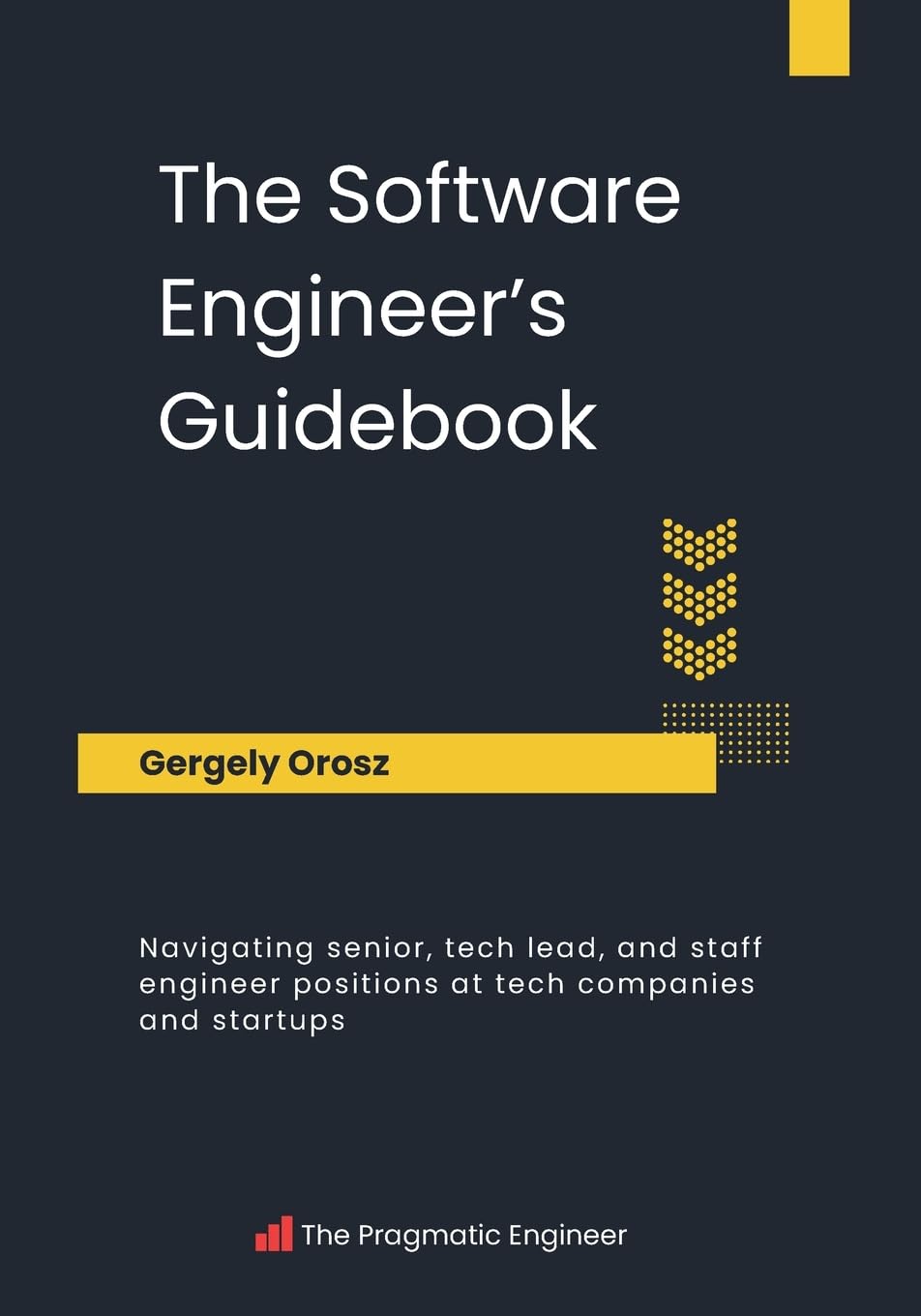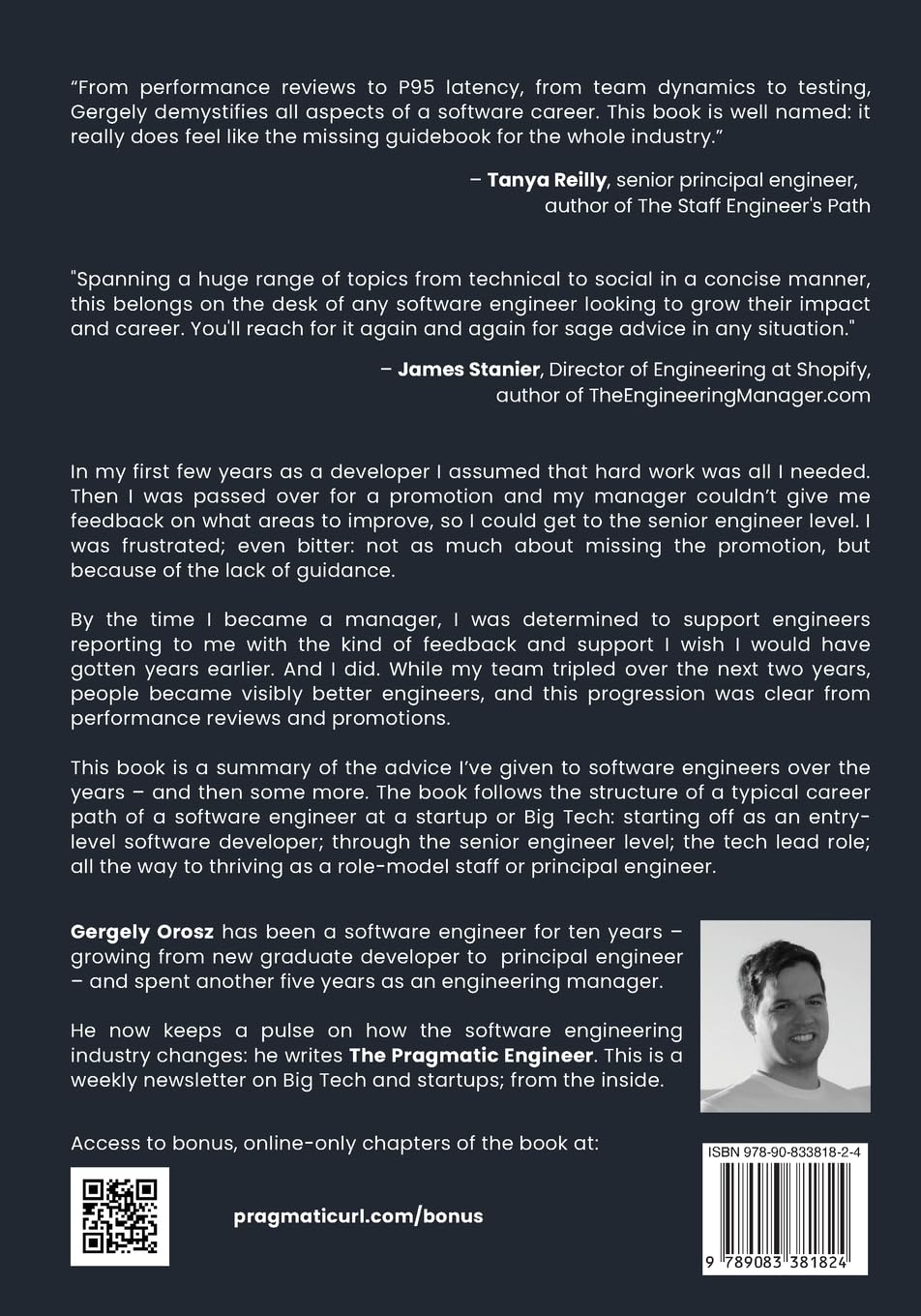
What’s the real difference between a senior engineer, a tech lead, and a staff engineer?
Understanding the Journey
Navigating my career as a software engineer has always been a blend of excitement and confusion. Each step up the ladder comes with new responsibilities, expectations, and challenges. “The Software Engineer’s Guidebook: Navigating senior, tech lead, and staff engineer positions at tech companies and startups” has been an invaluable resource for me, providing clarity on the often nebulous distinctions between these roles and what it takes to succeed in each position.
Who’s This Guide For?
This guidebook targets software engineers at various points in their careers. Whether I’m a recent grad or a seasoned pro looking to advance, there’s valuable information tailored to my needs. The author demonstrates a solid understanding of the unique challenges faced by engineers in tech companies and startups.
New Graduates
For fresh graduates like I was not too long ago, this guide breaks down what to expect in the workforce. It sheds light on the initial responsibility levels, skill requirements, and potential career paths that follow the entry-level phase.
Mid-Career Professionals
If I find myself in the mid-stages of my career, the guide navigates the transition into senior roles. It discusses not just technical skills but also the soft skills I need to develop to thrive in leadership positions.
Senior Engineers Looking to Advance
Even for those already in senior positions, the guide covers how to step into tech lead or staff engineer roles. It emphasizes strategic thinking, mentoring, and how to influence the broader engineering team effectively.
Roles Breakdown: Senior Engineer vs. Tech Lead vs. Staff Engineer
The book provides clear distinctions between senior engineers, tech leads, and staff engineers. This breakdown has been super helpful for me in recognizing what I should focus on based on my career goals.
| Role | Key Responsibilities | Skills Needed | Career Progression |
|---|---|---|---|
| Senior Engineer | Develops high-quality software, mentors junior engineers | Advanced coding, problem-solving | Tech Lead, Staff Engineer |
| Tech Lead | Oversees projects, manages team dynamics, and aligns technical vision | Leadership, communication, project management | Senior Engineer, Staff Engineer |
| Staff Engineer | Sets technical direction, influences engineering processes across teams | Strategic thinking, architecture design | Engineering Manager, Director |
Senior Engineer Responsibilities
As a senior engineer, developing high-quality software is my bread and butter. But that’s not all; I also have a responsibility to mentor junior engineers, providing guidance and support as they navigate their own paths. The guidebook helps me recognize that this role is not merely about coding but also about fostering talent.
Tech Lead Responsibilities
As I progress toward a tech lead position, the guidebook emphasizes the importance of overseeing projects and managing team dynamics. It teaches me how to balance maintaining a technical vision with people management, which is crucial for team success. Learning how to build a communication bridge between technical and non-technical stakeholders has been eye-opening.
Staff Engineer Responsibilities
Transitioning into a staff engineer role means setting the technical direction for my team and influencing processes across departments. The guide helps me develop strategic thinking and architectural design skills. It highlights the importance of being a thought leader and making decisions that impact the company’s broader technical landscape.
Skill Development and Continuous Learning
What stands out in “The Software Engineer’s Guidebook” is its emphasis on continuous learning and development. The tech industry is ever-evolving, and I’ve realized that remaining updated is crucial for my career advancement.
Importance of Soft Skills
In addition to honing technical skills, the book stresses the importance of soft skills. I’ve found that good communication, teamwork, and adaptability are pivotal. The author outlines practical ways to improve these skills, such as engaging in team discussions and seeking feedback from peers.
Technical Skills Are Essential, Too
Of course, technical expertise never takes a backseat. The guidebook provides resources for developing advanced coding abilities, including popular online platforms and boot camps. This section is particularly useful for my ongoing journey to mastery.
Building a Personal Brand
Another fascinating aspect is the advice on building a personal brand as a software engineer. I learned that my online presence, including platforms like GitHub and LinkedIn, should reflect my skills and accomplishments. The author includes tips on networking and showcasing projects that speak to my strengths.
Navigating Company Culture
Different tech companies and startups have unique cultures, and this guide provides insights into how to navigate and adapt to them. I found it beneficial to understand how to assess company culture during the interview process.
Defining Company Values
The book encourages me to prioritize personal alignment with the company’s values. When I look for a job, I ask myself if my values resonate with the organization’s culture. This alignment is essential for my long-term happiness and success.
Adapting to Team Dynamics
Team dynamics can significantly impact performance and job satisfaction. The guidebook offers tips on how to adapt to different environments while maintaining authenticity. I’ve learned that finding common ground with my coworkers helps in fostering collaboration.
Conflict Resolution within Teams
Conflict in teams is inevitable. The guide provides strategies for resolving these conflicts constructively. I appreciate learning how effective communication can prevent misunderstandings and foster a more cohesive team environment.
Leadership Skills: A Must for Advancement
The journey from an engineer to a tech lead or staff engineer requires honing leadership skills, and “The Software Engineer’s Guidebook” delivers advice that resonates with me.
Mentorship and Team Development
One crucial leadership aspect that the guide emphasizes is mentorship. I’ve come to appreciate the value of nurturing talent in my team. The book illustrates how great leaders invest time in their juniors, helping them develop their skills and grow professionally.
Strategic Decision Making
The author discusses strategic decision-making skills I’ll need as I progress. Understanding how to weigh options and making informed decisions is integral to influencing the project’s success. Through various scenarios outlined in the guide, I learned how to approach complex situations analytically.
Navigating Organizational Politics
Politics can often be present in tech environments. The guide provides pragmatic advice on how to navigate these waters without compromising my values. Building alliances and maintaining professionalism has been a significant area of focus for me.
The Application Process: Tips and Tricks
Looking for a new position or moving up within my company can sometimes feel daunting. The guide offers clear advice to ease this process.
Crafting a Winning Resume
The guidebook outlines how to craft a resume that stands out. I’ve learned that quantifying achievements matters—showcasing the impact of my work rather than just listing my responsibilities can set me apart.
Preparing for Interviews
The guide also offers tips for interview preparation, including researching the company and practicing behavioral questions. I’ve found that mock interviews can significantly boost my confidence and readiness, thanks to exercises suggested in the book.
Negotiating Offers
Negotiating salary and benefits can feel uncomfortable for many, including me. However, the guide provides strategies to approach negotiations confidently. I’ve learned how to articulate my worth and understand market standards, making the process smoother.
Real-World Experiences and Case Studies
What I appreciate about “The Software Engineer’s Guidebook” is the inclusion of real-world experiences and case studies. It’s not just theoretical; it includes insights from professionals who have traversed these paths successfully.
Learning from Failures
I resonate with the idea that failures are part of the growth process. The guidebook includes stories from professionals who faced setbacks and what they learned. It reminds me that resilience is key, and every challenge can lead to personal and professional development.
Success Stories
Additionally, the success stories shared are both motivational and educational. These narratives serve as a reminder that navigating these roles can lead to incredibly fulfilling careers, provided I’m willing to put in the effort.
Final Thoughts
Reflecting on the contents of “The Software Engineer’s Guidebook,” it’s evident that the journey in tech is multifaceted and requires a blend of skills, adaptability, and persistence. Each section has equipped me with the tools and knowledge necessary to navigate my career effectively.
A Practical Resource
This guidebook is not just a read; it’s a practical resource I can refer to throughout my career journey. The clear layout, actionable insights, and relatable anecdotes make it a companion that I’ll likely keep on my bookshelf—always within reach for guidance.
An Investment in My Career
Ultimately, investing in “The Software Engineer’s Guidebook” has been an investment in my career. The knowledge I’ve gained will undoubtedly support my path forward, helping me transition through roles with confidence and clarity.
Have I found my roadmap? In many ways, yes! This guidebook has paired well with my career ambitions, offering me the compass I need to navigate the tech landscape.
Disclosure: As an Amazon Associate, I earn from qualifying purchases.


